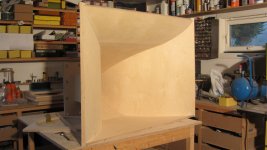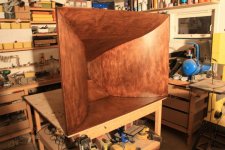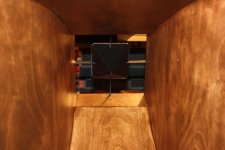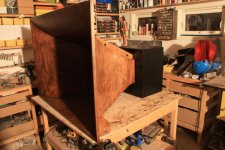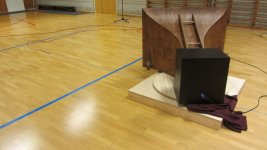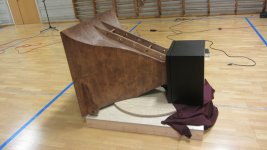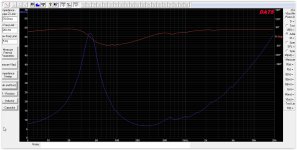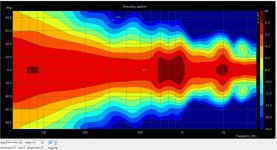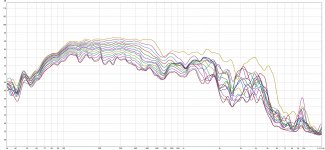The design of the midbass horn is progressing. Simulations look good. The horn has been simulated with these drivers: GPA-515-8-GHP, JBL 2220H, B&C 15FW76, B&C 15PLB76 and a new AE driver.
For a crossover at 600 Hz (at the highest), is there any benefit using an Alnico driver for a midbass horn? Or is ferrite with shorting ring just as good?
For a crossover at 600 Hz (at the highest), is there any benefit using an Alnico driver for a midbass horn? Or is ferrite with shorting ring just as good?
I am having trouble finding a 15" that has good midrange, as good as my ported Meyer 12". I tried a JBL 2220H and 2225 and it was not good enough. I used a horn with 12L sealed back chamber and open baffle, 80-400Hz, 2nd order. They model just fine in hornresp. I am starting think I don't need this kind of midbass horn. These 15" drivers are not usable above 200Hz. I will save them for a future gigantic horn, like Carpenters spiral horn.
Last edited:
Hi guys. An update.
A lot has happened since I started this thread.
Bjorn Kolbrek designed a mid-bass horn for me and we've also decided to try to commercialize it. First a prototype scale model with 1/4 size was built and measured.

It measured very well both horizontally and vertically and we went on to build a full size one.




The full size horn was than measured in a gym.



The horizontal polar is very uniform and looks great and a little better than how the smaller scale model measured. Vertically we did some measurements including the floor to see if the asymmetrical shape minimized the floor bounce, and it seems to work really well.
We used JBL 2220H besides a B&C driver to measure the horn with and the JBL 2220H driver has a cancellation around 600-700 Hz, which we know is driver related. We're uncertain if this inherit with the driver or if our used drivers are damaged or haven't been reconed properly.
Next step now is to find the best production method. We may also get our own driver developed.
A lot has happened since I started this thread.
Bjorn Kolbrek designed a mid-bass horn for me and we've also decided to try to commercialize it. First a prototype scale model with 1/4 size was built and measured.
It measured very well both horizontally and vertically and we went on to build a full size one.
The full size horn was than measured in a gym.
The horizontal polar is very uniform and looks great and a little better than how the smaller scale model measured. Vertically we did some measurements including the floor to see if the asymmetrical shape minimized the floor bounce, and it seems to work really well.
We used JBL 2220H besides a B&C driver to measure the horn with and the JBL 2220H driver has a cancellation around 600-700 Hz, which we know is driver related. We're uncertain if this inherit with the driver or if our used drivers are damaged or haven't been reconed properly.
Next step now is to find the best production method. We may also get our own driver developed.
Attachments
Last edited:
They work in Chrome but not in Explorer and Firefox. That's strange. Not sure what the cause is.Your pics aren't working....
Edit: I uploaded them again. Seems to work now.
Last edited:
Good to go now.
You say they measured well.....can we see the data? What are the rough physical dimensions? Thinking I need a midbass horn in my life [emoji6]
You say they measured well.....can we see the data? What are the rough physical dimensions? Thinking I need a midbass horn in my life [emoji6]
Roughly 4' (width) x 2.9' (height). Depth depends on rear chamber but without it it's about 2.95'.
I'm a little hesitant to share measurements because the JBL 2220H driver that was used had a cancellation and some resonances. Can be seen here:

However, I don't think this effected the horizontal directivity much, if any at all. So here's the horizontal polar.

Here's some vertical measurements which included the floor and shown with 1/12 oct. smoothing. Just be aware that the driver issue effected these.

I'm a little hesitant to share measurements because the JBL 2220H driver that was used had a cancellation and some resonances. Can be seen here:
However, I don't think this effected the horizontal directivity much, if any at all. So here's the horizontal polar.
Here's some vertical measurements which included the floor and shown with 1/12 oct. smoothing. Just be aware that the driver issue effected these.
Attachments
Not so useful to cross a 15" driver between 120-250Hz. The driver 2220H is perfect for this task, for example the 2225H will sound worse in a horn. But the horn is just too small for me. 🙁 I have a pair of similar horns and now use ported 2225H instead. I could use both if ever I get a castle.
Last edited:
That should be a great sounding horn. I highly recommend building a throat extension and using B&C 8PE21. It is worth the extra work IME.
Congrats team Bjørn!
Maybe you could try to run a sim with the BD-15: BD15 ?
That looks a bit like a modern day version of the 2220. Underhung motor with neo magnet. Looks very close to the 2220 in a quick sim I did. Le is a little high though and no mention of shorting rings or copper sleeve in the motor.
If you build your own driver I think an underhung vc, neo magnet(neo is exspensive but the cheaper shipping will make up for it) and a lot of copper in the motor would be interesting.
2.5 / 3" voice coil is plenty for home use and will save weight and inductance over a 4".
Maybe you could try to run a sim with the BD-15: BD15 ?
That looks a bit like a modern day version of the 2220. Underhung motor with neo magnet. Looks very close to the 2220 in a quick sim I did. Le is a little high though and no mention of shorting rings or copper sleeve in the motor.
If you build your own driver I think an underhung vc, neo magnet(neo is exspensive but the cheaper shipping will make up for it) and a lot of copper in the motor would be interesting.
2.5 / 3" voice coil is plenty for home use and will save weight and inductance over a 4".
That should be a great sounding horn. I highly recommend building a throat extension and using B&C 8PE21. It is worth the extra work IME.
An extension would make it a very deep horn. I forgot what your horn dimensions are for the 8PE21?
If you build your own driver I think an underhung vc, neo magnet(neo is exspensive but the cheaper shipping will make up for it) and a lot of copper in the motor would be interesting.
2.5 / 3" voice coil is plenty for home use and will save weight and inductance over a 4".
Maybe that is what makes the Altec 515 so popular.
I heard you can use a voice coil on the inside and outside to reduce Le.
An extension would make it a very deep horn. I forgot what your horn dimensions are for the 8PE21?
My horns have almost the same mouth at 47 by 26" and are only 48" deep mouth to throat entrance. 3.8" throat diameter.
Thanks Fredrik!Congrats team Bjørn!
Maybe you could try to run a sim with the BD-15: BD15 ?
That looks a bit like a modern day version of the 2220. Underhung motor with neo magnet. Looks very close to the 2220 in a quick sim I did. Le is a little high though and no mention of shorting rings or copper sleeve in the motor.
If you build your own driver I think an underhung vc, neo magnet(neo is exspensive but the cheaper shipping will make up for it) and a lot of copper in the motor would be interesting.
2.5 / 3" voice coil is plenty for home use and will save weight and inductance over a 4".
We'll take a look at the BD-15. I already had it bookmarked but I don't think we've simulated it.
The driver that we've considering using for a final horn rig has been simulated. It looks pretty amazing on paper. This particular driver keeps the level very high in frequency. A lot higher than we need, but it does make the horn very flexible. A crossover at 1KHz or higher wouldn't be a problem at all without sacrificing sensitivity. It will take probably at least 6 months before it's ready.
In the meantime, we're looking for a new driver that works as good as the JBL 2220. We've found a russian driver (Oberton) that remains the upper level like the JBL 2220 but that looses some in the lows.
My horns have almost the same mouth at 47 by 26" and are only 48" deep mouth to throat entrance. 3.8" throat diameter.
Hi POOH,
Wow this a liitle throat in relation to the cone size !
How do you made for extend in the low end the 350-400 Hz natural HF roll of of the B&C driver ? Thanks to the space between the throat and the cone surround ? How deep is it ? 3 cm ? Or is it simply the volume of load ?
The throat size is pretty standard for an 8". Romy the Cat uses a similar size for the Fane 8M.
Gorgeous horn - beautiful graphs - - here's a little C fold hypex horn - 7 cubic foot external bulk - indoor graph in messy room - driver a $59 "buyout" Community 12" - RCA-Fan says a 12pe32 will not go higher - I need to find out. 5/9" Baltic birch with braces is plenty stiff enough for a little folded horn (am affixed on Karlsons - love the damn things😀 - great on bowed bass/cello)
graph
http://i.imgur.com/tHPM6Kx.gif
picture
http://i.imgur.com/8qag2Xo.jpg
folding geometry
http://usr.audioasylum.com/images/2/21168/2Bwith_reflector.gif
graph
http://i.imgur.com/tHPM6Kx.gif
picture
http://i.imgur.com/8qag2Xo.jpg
folding geometry
http://usr.audioasylum.com/images/2/21168/2Bwith_reflector.gif
Last edited:
Thanks guys.
The BD15 driver didn't simulate as well as JBL 2220H.
However, we have other options and are working on new designs.
The BD15 driver didn't simulate as well as JBL 2220H.
However, we have other options and are working on new designs.
- Home
- Loudspeakers
- Multi-Way
- Pros and cons of different midbass horns

